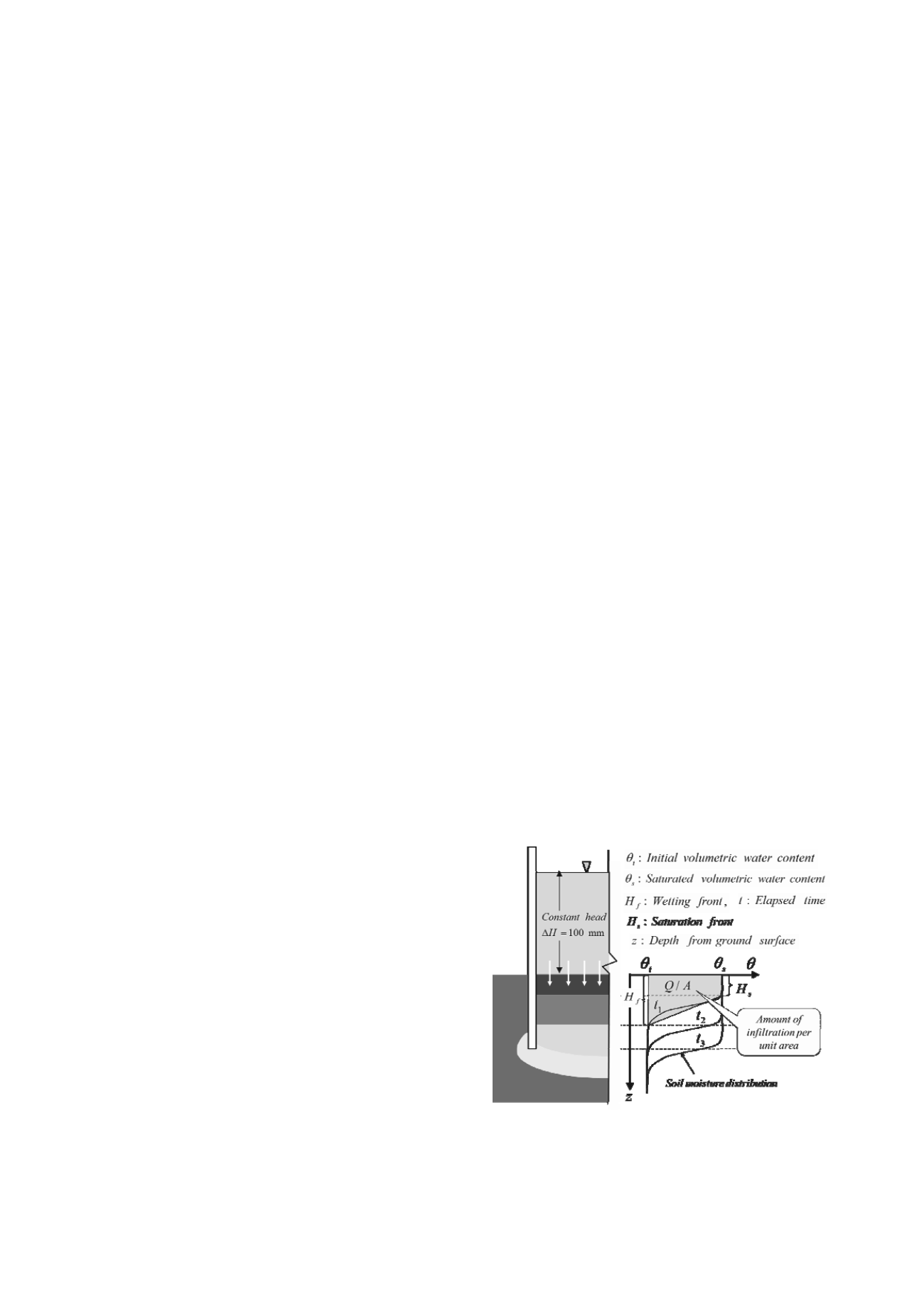
1195
Measurement of Unsaturated Ground Hydraulic Properties using a Dynamic State
Soil Moisture Distribution Model
Mise en œuvre de l'évaluation d'une mesure des propriétés hydrauliques d'un sol non saturé
par un modèle dynamique de distribution de l'humidité
Sugii T., Yamada K., Asano N., Yamada Y.
Dept. of Civil Engineering, Chubu University, Aichi, Japan
ABSTRACT: This paper presents a new in-situ test for producing a moisture characteristic curve and estimating unsaturated hydraulic
conductivity using a reduced number of measurement parameters. Measurement parameters are restricted to determining the amount
of infiltration and the pressure head, and can be used to determine the hydraulic properties of unsaturated soils. The model expresses
the dynamic state of moisture distribution using a sigmoid function, and does not require measurement of the amount of soils
moisture. Experimental results showed that suction of the moisture characteristic curve was small and estimated based on the
influence of pore air pressure, and the values obtained for saturated and unsaturated hydraulic conductivity were in agreement with
the results of laboratory tests.
RÉSUMÉ : Nous présentons ici la mise en œuvre d'une expérience in situ , destinée à définir une courbe caractéristique de l'humidité
et la conductivité hydraulique d'un sol nonsaturé. Cette méthode, basée sur un modèle de distribution proposé par les auteurs a
l'avantage d’éliminer un paramètre de mesure. Les paramètres de mesure nécesssaires pour déterminer la conductivité hydraulique du
sol non saturé sont seulement le degré d'infiltration et la pression hydraulique du haut. Le modèle développé par les auteurs utilise une
courbe sigmoïde de mesure de distribution de l'humidité dynamique, ceci permet de supprimer la mesure du taux d'humidité. Nous
avons comparé la succion obtenue pour la courbe caractéristique d'humidité et observé qu'elle est un peu plus faible sous l'influence
de la pression d'air des pores, mais nous pouvons conclure que nos résultats de conductivité hydraulique, en sol saturé et non saturé,
sont comparables aux résultats expérimentaux en laboratoire.
KEYWORDS: Unsaturated soils, Hydraulic conductivity, In-situ test, soil water characteristic curve
1 INTRODUCTION
Hydraulic conductivity of the ground depends on the degree of
saturation. Since boundary conditions vary, hydraulic
conductivities in in situ tests are classified into four categories;
unsaturated and saturated hydraulic conductivities of soils
below the groundwater level, which are usually saturated, and
unsaturated and saturated hydraulic conductivities of soils that
are above the groundwater level, which are usually unsaturated.
In embankments or slopes where groundwater levels are deep,
soils are typically in an unsaturated state. However, intense
rainfall and seepage water change the soil condition from being
unsaturated to saturated. Consequently, the development of an
in-situ test for evaluating the hydraulic properties of saturated
and unsaturated soils is required. Current in situ permeability
tests of unsaturated sediments require special equipment, and
the method used to saturate the foundation in such tests is often
difficult. These problems of soils have made it difficult to
develop effective techniques for assessing the hydraulic
characteristics of soils in practice.
This study therefore sought to develop a simple method for
evaluating the hydraulic properties of foundations, which are
typically unsaturated. This method only measures osmotic flow
and pressure head, but it is capable of estimating hydraulic
conductivity and producing a moisture characteristic curve of
the unsaturated foundation by using a dynamic state moisture
distribution model developed by the authors.
2 WETTING AND SATURATION FRONTS
In order to clarify the hydraulic properties of foundations in-situ,
a simple examination method is desirable. A simple permeation
examination was therefore used for increasing the degree of
saturation of the foundation. Wetting fronts advance within
foundations and increase the degree of saturation in permeation
tests. Yong (1975) showed that the distance over which a
wetting front advances in a one-dimensional lateral flow is
proportional to the square root of time. They also observed that
the relation was established under conditions of one-
dimensional vertical flow. In this study, we referred to the depth
of boundary that reaches saturation from being unsaturated in
the one-dimensional vertical flow as the “saturation front”
(Fig.1). We then used a numerical simulation to determine
whether the square root of time could be applied to estimate the
depth of the saturation front. The results of the numerical
simulations are shown in Fig. 2.
Figure 1. Permeation test in one-dimensional vertical flow and
variables used in permeation test.


